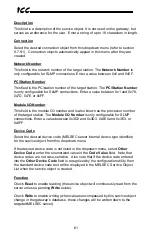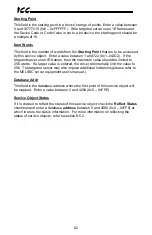
51
ICC
Con Data Size (“Consumed Data Size”)
This field defines the number of bytes to consume (receive from the
server device). Enter a value of 1 or more.
RPI
This field is the Requested Packet Interval and is specified in units of
milliseconds. The minimum supported RPI is 10ms.
Mult
Specifies the connection timeout multiplier. The connection’s timeout
time is determined by multiplying the RPI times the connection timeout
multiplier.
Triggering Mechanism Group
The triggering mechanism group provides a certain degree of control over the
service object behavior (the situations in which connections are established or
when data is exchanged with the remote device).
If the
Auto Trigger
checkbox is checked, then the gateway will automatically
handle the service object’s production/consumption or reading/writing (depending
on whether the service object is a class 1 or class 3 connection).
On the other hand, there may be situations where external (manual) control over
service object data transfers is desirable. This can be accomplished by
manipulating bit(s) in the gateway’s database, either by injecting data into the
gateway via another server protocol, or by new data values being actively read
into the database via service objects associated with a client protocol.
To manually activate a service object, uncheck the
Auto Trigger
checkbox and
enter a database
Address
(0x0 – 0xFFF) and an 8-bit
Bitmask
. Only 1 bit may
be set in the
Bitmask
, and each trigger bit at a certain
Address
may only be
associated with one service object (in other words, there is a unique “one service
object to one bit” association). Therefore, up to 8
Bitmasks
(0x01, 0x02, 0x04,
0x08, 0x10, 0x20, 0x40 and 0x80) for 8 different service objects can be defined at
any given database
Address
. While the definition of what constitutes a valid
trigger bit is consistent for all service objects, the triggering mechanism behavior
is different for class 1 and class 3 message types.
For class 1 message types
•
If the
Auto Trigger
checkbox is checked, then the class 1 I/O connection will
always be enabled. This means that the I/O connection will be established
and production/consumption will continuously occur at regular intervals.
•
If the
Auto Trigger
checkbox is unchecked, then the class 1 connection will
be enabled only as long as the designated trigger bit is a “1”: if the trigger bit
becomes a “0”, then the client will close the class 1 connection to the server.
If the trigger bit transitions back to a value of “1”, the client will once again
















































